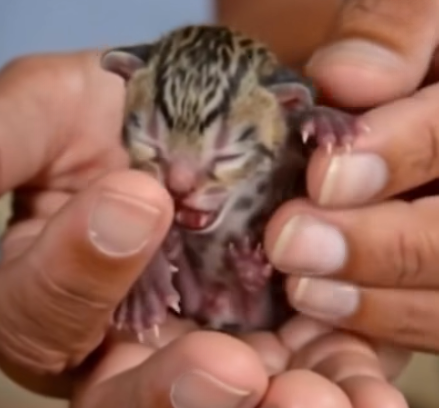
A Chance Encounter on a Warm Evening
In the heart of Thailand, during what seemed like an ordinary family walk on a pleasant evening, a discovery was made that would forever change how one family viewed wildlife. As the sun dipped below the horizon and the streets quieted, the family noticed a tiny figure curled up near a sidewalk corner. At first glance, it looked like a helpless kitten, abandoned and vulnerable, mewing softly for attention.
Curious and concerned, the family approached. The little creature was no bigger than the palm of a hand, its fur slightly matted, and its eyes barely open. It was the kind of sight that would tug at anyone’s heartstrings. Without hesitation, they scooped up the baby animal, determined to protect it from the dangers of the night.
But as they took a closer look, they realized that something about this “kitten” was unusual. Its face, markings, and build didn’t quite resemble the domestic cats they had seen before.
What they thought would be a simple act of kindness soon turned into a remarkable wildlife rescue story.
The Call to Wildlife Experts
Concerned about the kitten’s strange appearance, the family contacted the Wildlife Friends Foundation Thailand (WFFT), an animal welfare group well-known for protecting and rehabilitating animals across the region.
When representatives from the organization arrived, they examined the small feline carefully. At first, even the experts were taken aback by the animal’s appearance. After some observation and discussion, the truth came to light: this wasn’t an ordinary house cat at all.
It was a fishing cat—a rare and vulnerable species of wild feline native to South and Southeast Asia.
What Makes Fishing Cats So Unique?
Fishing cats (Prionailurus viverrinus) are not your average cats. Unlike domestic felines that many families raise as pets, fishing cats are medium-sized wild cats adapted to wetland environments.
Here are a few fascinating facts about these remarkable creatures:
- Size and Build: Fishing cats are much stockier and larger than most house cats. An adult fishing cat can grow nearly twice as big, with strong limbs built for swimming and hunting.
- Love for Water: Unlike many feline species that avoid water, fishing cats thrive in it. They are excellent swimmers and are often found near rivers, streams, mangroves, and swamps.
- Diet and Hunting: True to their name, these cats are skilled hunters of aquatic animals. Fish, frogs, crustaceans, and even small mammals form a large part of their diet.
- Status in the Wild: Fishing cats are currently classified as Vulnerable on the International Union for Conservation of Nature’s (IUCN) Red List. Their numbers have declined rapidly in recent decades due to habitat loss and human conflict.
This little “kitten,” found by chance, was actually a critically important representative of a species struggling to survive in today’s world.
The Mystery of the Missing Mother
The experts at WFFT estimated that the fishing cat cub was only a few hours old when it was discovered. Normally, newborns of this species are closely guarded by their mothers, who keep them hidden in dense vegetation until they are old enough to fend for themselves.
So why was this tiny cub alone?
The answer remains unclear. Perhaps the mother had been forced to abandon her young due to nearby human activity. Or maybe she had been harmed before she could return to her baby. The reason may never be known, but what was certain was that without intervention, the cub would not have survived the night.
A New Family for Simba
Despite knowing that fishing cats are wild animals and not ideal domestic companions, the family had already formed a deep emotional bond with the little cub. They asked the wildlife group if they could care for him temporarily. The organization, recognizing the family’s genuine concern, provided them with advice on how to support the baby safely while keeping conservation goals in mind.
The family affectionately named the cub Simba, inspired by the beloved lion character from popular culture. Day by day, they bottle-fed him, kept him warm, and ensured he received the nurturing care he needed to grow.
Simba, in turn, grew attached to his human caretakers. Though wild at heart, he recognized them as his protectors, responding with affection and trust.
The Growing Concern for Conservation
While Simba’s story was heartwarming, it also highlighted the sobering reality that fishing cats face in Thailand and beyond. According to wildlife experts, the survival rate of fishing cats in the wild is alarmingly low.
Several factors contribute to this decline:
- Habitat Destruction
Wetlands, the primary home of fishing cats, are rapidly disappearing due to urban expansion, agriculture, and pollution. Every drained swamp or cleared mangrove forest means less room for these animals to thrive. - Poaching and Retaliatory Killings
In rural areas, fishing cats are sometimes killed by fishermen or farmers who see them as competition for resources. Sadly, this has been identified as one of the leading causes of mortality for the species. - Climate Change
Rising sea levels and changing rainfall patterns threaten delicate wetland ecosystems. As these habitats shrink, so does the fishing cat population.
The Wildlife Friends Foundation Thailand has emphasized that saving animals like Simba is not just about one individual, but about protecting an entire species from vanishing.
Simba’s Transformation
Over time, Simba began to reveal his natural instincts. Though he lived in a safe environment with his human family, his behaviors reminded everyone that he was, at his core, a wild cat.
He showed a strong fascination with water, often dipping his paws into bowls or chasing ripples across puddles. When introduced to small fish, he displayed remarkable hunting skills, confirming his true nature as a born fisherman.
Watching Simba grow was both heartwarming and bittersweet. The family loved him dearly, but they knew that his future might one day need to be with a conservation center or a sanctuary where he could interact with others of his kind.
A Broader Lesson for Humanity
Simba’s story is more than just a tale of rescue and love. It serves as a reminder of the delicate balance between humans and wildlife. Too often, human expansion and carelessness push species like the fishing cat to the brink of extinction.
Yet, at the same time, human compassion can make the difference between life and death for vulnerable creatures. The Thai family’s quick action gave Simba a chance to live, and in doing so, brought global attention to a species that many people have never even heard of.
Protecting Fishing Cats for the Future
If Simba’s story has taught us anything, it is that protecting fishing cats requires a multi-faceted approach:
- Education and Awareness: Communities living near wetlands must be educated about the importance of fishing cats and the role they play in ecosystems.
- Stronger Protections: Governments and organizations need to strengthen legal protections for wetlands and wildlife.
- Conservation Programs: Sanctuaries, breeding programs, and wildlife rehabilitation centers are crucial for giving orphaned or injured animals a chance at survival.
- Responsible Tourism: Eco-tourism initiatives can raise awareness and provide funding for conservation efforts while encouraging respect for wild habitats.
A Story That Inspires Hope
Today, Simba continues to grow under the care of the family and with the support of wildlife experts. His survival represents not just luck, but the power of empathy and the importance of conservation.
For the family, what began as a casual evening walk turned into a once-in-a-lifetime experience. They didn’t just save a kitten; they helped preserve a symbol of Thailand’s natural heritage.
For the rest of us, Simba’s journey is a call to action. Every small effort—whether it’s supporting conservation groups, spreading awareness, or simply respecting the wildlife around us—can make a lasting difference.
Conclusion
The story of Simba, the abandoned kitten who turned out to be a rare fishing cat, is one of resilience, compassion, and the urgent need for conservation. It reminds us that nature is full of surprises and that even the smallest acts of kindness can have a profound impact on the survival of a species.
As long as people continue to care and take action, there is hope that fishing cats, and countless other vulnerable creatures, will not just survive, but thrive for generations to come.




